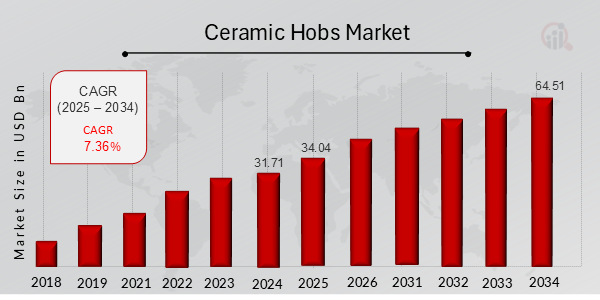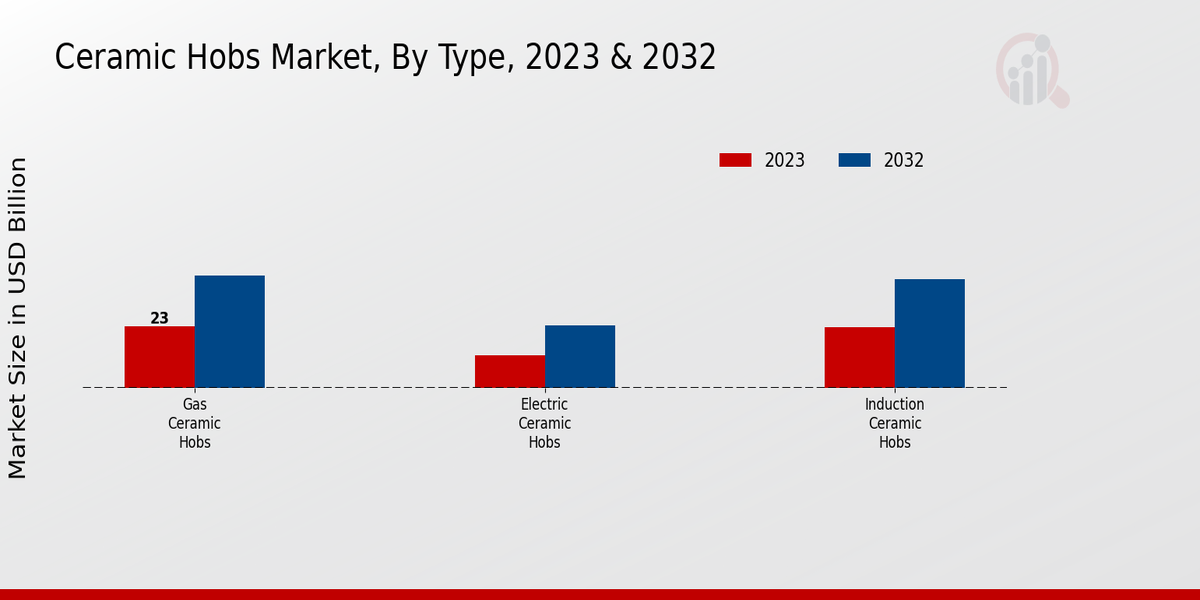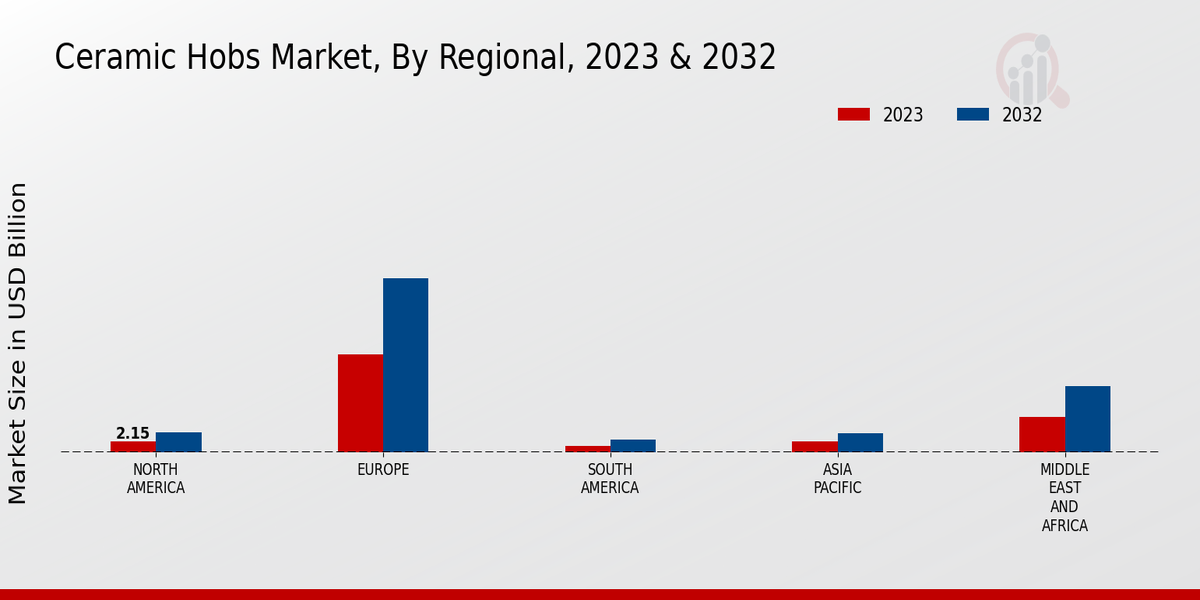Global Ceramic Hobs Market Overview
As per MRFR analysis, the Ceramic Hobs Market Size was estimated at 31.71 (USD Billion) in 2024. The Ceramic Hobs Market Industry is expected to grow from 34.04 (USD Billion) in 2025 to 64.51 (USD Billion) till 2034, at a CAGR (growth rate) is expected to be around 7.36% during the forecast period (2025 - 2034)
Key Ceramic Hobs Market Trends Highlighted
Ceramic hobs are gaining increasing popularity due to their sleek aesthetic, ease of cleaning, and energy efficiency. The rising demand for technologically advanced kitchen appliances and renovations in the building and construction industry are driving the market forward.
The integration of induction technology into ceramic hobs is a key trend, allowing for faster heating and precise temperature control. Smart features, such as touch controls, automatic switch-off, and residual heat indicators, enhance user convenience.
Moreover, the increasing awareness of healthy cooking practices is contributing to the adoption of ceramic hobs, as they are non-porous and non-toxic. Key opportunities lie in the expansion into emerging markets, collaboration with smart home ecosystems, and development of energy-efficient models. Technological innovations, such as seamless integration with other kitchen appliances, will shape future market trends.

Source: Primary Research, Secondary Research, MRFR Database and Analyst Review
Ceramic Hobs Market Drivers
Rising Demand for Energy-Efficient Cooking Appliances
Ceramic hobs have gained significant popularity in the global market due to their energy efficiency compared to traditional gas or electric cooktops. The increasing awareness of energy conservation and the implementation of government regulations promoting sustainable practices have driven the demand for energy-efficient appliances. Ceramic hobs offer faster heating times, reduced heat loss, and better temperature control, making them an attractive option for consumers seeking to reduce their energy consumption.Additionally, the sleek and modern designs of ceramic hobs complement contemporary kitchen aesthetics, further contributing to their growing appeal.
Technological Advancements and Innovation
Technological advancements in the Ceramic Hobs Market Industry have played a crucial role in enhancing the functionality and features of ceramic hobs. Induction hobs, which utilize electromagnetic energy to generate heat directly in the cookware, have gained traction due to their superior energy efficiency and precise temperature control. Additionally, advancements in touch controls, safety features, and connectivity options have improved the user experience and convenience of ceramic hobs.Continuous innovation in design and materials has resulted in the development of durable and aesthetically pleasing hobs that cater to the evolving needs of consumers.
Expanding Construction and Renovation Activities
The growth of the construction and renovation industry has positively impacted the demand for ceramic hobs. New residential and commercial buildings often incorporate modern and energy-efficient appliances, including ceramic hobs. The increasing disposable income and urbanization in emerging markets have led to a surge in construction activities, further driving the demand for ceramic hobs. Moreover, the trend towards open-plan kitchens and seamless designs has increased the visibility of cooktops, making aesthetic considerations a key factor in consumer purchasing decisions.
Ceramic Hobs Market Segment Insights
Ceramic Hobs Market Type Insights
The Ceramic Hobs Market is segmented by Type into Gas Ceramic Hobs, Electric Ceramic Hobs, and Induction Ceramic Hobs. In 2023, the Induction Ceramic Hobs segment held the largest market share, accounting for around 45% of the Ceramic Hobs Market revenue. The Electric Ceramic Hobs segment is expected to grow at the highest CAGR during the forecast period, owing to its increasing popularity in residential and commercial applications due to its energy efficiency and ease of use. Gas Ceramic Hobs offer a traditional cooking experience with precise flame control and instant heat, making them suitable for professional chefs and home cooks alike.Electric Ceramic Hobs provide a sleek and modern look with their smooth surface and radiant heat, offering consistent and even cooking. Induction Ceramic Hobs use electromagnetic induction technology to generate heat directly in the cookware, resulting in faster cooking times, energy efficiency, and precise temperature control. The growth of the Ceramic Hobs Market is attributed to several factors, including rising disposable income, increasing urbanization, and the growing popularity of modern kitchen designs. The market is also driven by the increasing demand for energy-efficient and convenient cooking appliances.Key players in the Ceramic Hobs Market include Bosch, Siemens, Whirlpool, Electrolux, and LG Electronics. These companies are focusing on product innovation and expanding their distribution networks to gain a competitive edge in the market. The market is expected to witness significant growth in the coming years, driven by the increasing adoption of ceramic hobs in both residential and commercial applications.

Source: Primary Research, Secondary Research, MRFR Database and Analyst ReviewCeramic Hobs Market Burner Count Insights
The Ceramic Hobs Market is segmented by burner count into Two Burners, Three Burners, Four Burners, and Five Burners or More. In 2023, the Two Burners segment held the largest market share, accounting for 42.5% of the Ceramic Hobs Market revenue. The Three Burners segment is expected to grow at a CAGR of 7.8% during the forecast period, owing to the increasing demand for energy-efficient and convenient cooking appliances. The Four Burners segment is also expected to witness significant growth, with a projected CAGR of 7.5%. The Five Burners or More segment is anticipated to grow at a steady pace, driven by the growing popularity of large families and gatherings.
Ceramic Hobs Market Shape Insights
The Ceramic Hobs Market is segmented by shape into Rectangular, Round, Square, and Custom Shapes. Rectangular ceramic hobs are the most popular shape, accounting for over 60% of the market share in 2023. They are preferred for their versatility and ability to accommodate different cookware sizes. Round ceramic hobs are the second most popular shape, with a market share of around 25%. They are ideal for smaller kitchens or for those who prefer a more traditional look. Square ceramic hobs are less common, with a market share of around 10%. They are often used in contemporary kitchens or for those who want a more unique look.Custom shapes ceramic hobs are the least common, with a market share of less than 5%. The growth of the market is attributed to the increasing popularity of ceramic hobs as they are more energy-efficient and durable than traditional gas or electric hobs. Additionally, the rising demand for luxury kitchens and the increasing number of renovation projects are also contributing to the growth of the market.
Ceramic Hobs Market Control Type Insights
The Ceramic Hobs Market is segmented by Control Type into Knob Controls, Touch Controls, and Hybrid Controls. Among these, Knob Controls held the largest market share in 2023, accounting for over 40% of the global market revenue. Touch Controls are expected to witness the fastest growth rate during the forecast period, owing to their sleek design and ease of use. Hybrid Controls, which combine the features of both Knob Controls and Touch Controls, are also gaining popularity, due to their versatility and convenience. The increasing demand for smart home appliances and the growing popularity of induction hobs are key factors driving the growth of the Ceramic Hobs Market.
Ceramic Hobs Market Features Insights
The 'Features' segment plays a crucial role in driving the Ceramic Hobs Market growth. The market witnessed a surge in demand for advanced features that enhance user convenience and safety. 'Booster Function' enables rapid heating, significantly reducing cooking time. 'Child Safety Lock' ensures safety in households with children, preventing accidental activation. 'Residual Heat Indicator' alerts users to residual heat on the hob surface, minimizing the risk of burns. 'Timer/Countdown Function' allows users to set cooking durations, ensuring precise cooking and preventing overcooking.'Bridge Function' enables the combination of two cooking zones, accommodating large cookware. These features contribute to the overall market growth, with increasing consumer demand for efficient and user-friendly cooking appliances. According to market research, the Ceramic Hobs Market revenue is projected to reach USD 38.23 billion by 2024, driven by the rising popularity of these advanced features.
Ceramic Hobs Market Regional Insights
The regional segmentation of the Ceramic Hobs Market offers valuable insights into market dynamics and growth prospects across different regions. North America is projected to hold a significant share of the market in 2023, driven by the presence of major market players, advanced infrastructure, and growing demand for energy-efficient appliances. Europe is also a key region, with established markets in countries such as Germany, France, and the United Kingdom. The APAC region is expected to witness robust growth, driven by rapid urbanization, rising disposable incomes, and increasing awareness of energy efficiency.South America and MEA are emerging markets with growing potential, as urbanization and economic development fuel demand for Ceramic Hobs.

Source: Primary Research, Secondary Research, MRFR Database and Analyst Review
Ceramic Hobs Market Key Players And Competitive InsightsMajor players in Ceramic Hobs Market industry are constantly striving to gain a competitive edge by introducing innovative products and expanding their global reach. Leading Ceramic Hobs Market players are focusing on research and development to enhance the efficiency and functionality of their products. Strategic partnerships and collaborations are also becoming increasingly common in the Ceramic Hobs Market Competitive Landscape.One of the leading companies in the Ceramic Hobs Market is BSH Hausgeräte GmbH. The company offers a wide range of ceramic hobs under its Bosch, Siemens, and Neff brands. BSH Hausgeräte GmbH has a strong global presence and is known for its innovative products and high-quality standards. The company is continuously investing in research and development to improve the performance and features of its ceramic hobs.A major competitor in the Ceramic Hobs Market is Electrolux AB. The company offers a variety of ceramic hobs under its Electrolux, AEG, and Zanussi brands. Electrolux AB has a strong presence in Europe and Asia-Pacific. The company is focused on providing energy-efficient and user-friendly ceramic hobs. Electrolux AB is also investing in research and development to develop new and innovative products.
Key Companies in the Ceramic Hobs Market Include
- Midea Group
- Gree Electric Appliances
- Haier
- BSH Hausgeräte
- Electrolux
- Galanz
- LG Electronics
- Hisense Group
- Fagor
- Elica
- Smeg
- Whirlpool
- Samsung Electronics
Ceramic Hobs Market Industry Developments
The Ceramic Hobs Market is projected to reach USD 64.51 billion by 2034, exhibiting a CAGR of 7.36% during the forecast period. The market growth is attributed to the rising demand for energy-efficient and stylish cooking appliances in residential and commercial sectors. Moreover, increasing disposable income and changing lifestyles are further fueling market expansion. Asia Pacific is expected to hold a significant market share due to rapid urbanization, growing construction activities, and increasing consumer spending. Key players in the market include Whirlpool, Electrolux, Bosch, Siemens, and LG Electronics, who are focusing on product innovation and strategic partnerships to gain a competitive edge. Recent developments include the launch of induction ceramic hobs with advanced features such as touch control, automatic shut-off, and child lock for enhanced safety and convenience.
Ceramic Hobs Market Segmentation Insights
- Ceramic Hobs Market Type Outlook
- Gas Ceramic Hobs
- Electric Ceramic Hobs
- Induction Ceramic Hobs
- Ceramic Hobs Market Burner Count Outlook
- Two Burners
- Three Burners
- Four Burners
- Five Burners or More
- Ceramic Hobs Market Shape Outlook
- Rectangular
- Round
- Square
- Custom Shapes
- Ceramic Hobs Market Control Type Outlook
- Knob Controls
- Touch Controls
- Hybrid Controls
- Ceramic Hobs Market Features Outlook
- Booster Function
- Child Safety Lock
- Residual Heat Indicator
- Timer/Countdown Function
- Bridge Function
- Ceramic Hobs Market Regional Outlook
- North America
- Europe
- South America
- Asia Pacific
- Middle East and Africa
| Report Attribute/Metric |
Details |
|
Market Size 2024
|
31.71 (USD Billion)
|
|
Market Size 2025
|
34.04 (USD Billion)
|
|
Market Size 2034
|
64.51 (USD Billion)
|
|
Compound Annual Growth Rate (CAGR)
|
7.36% (2025 - 2034)
|
|
Report Coverage
|
Revenue Forecast, Competitive Landscape, Growth Factors, and Trends
|
|
Base Year
|
2024
|
|
Market Forecast Period
|
2025 - 2034
|
|
Historical Data
|
2019 - 2023
|
| Market Forecast Units |
USD Billion |
| Key Companies Profiled |
Midea Group, Gree Electric Appliances, Haier, BSH Hausgeräte, Electrolux, Galanz, LG Electronics, Hisense Group, Fagor, Elica, Smeg, Whirlpool, Samsung Electronics |
| Segments Covered |
Type, Burner Count, Shape, Control Type, Features, Regional |
| Key Market Opportunities |
Booming construction sector rising disposable income technological advancements increasing demand for energyefficient appliances growing popularity of induction hobs |
| Key Market Dynamics |
Rising disposable income Technological advancements Increasing demand for energyefficient appliances |
| Countries Covered |
North America, Europe, APAC, South America, MEA |
Frequently Asked Questions (FAQ) :
The Ceramic Hobs Market is expected to reach a valuation of 31.71 Billion USD in 2024.
The Ceramic Hobs Market is projected to grow at a CAGR of 7.36% from 2025 to 2034.
The Asia-Pacific region is expected to hold the largest market share in the Ceramic Hobs Market by 2032.
Rising demand for energy-efficient appliances, increasing disposable income, and growing urbanization are key factors driving the growth of the Ceramic Hobs Market.
Some of the key competitors in the Ceramic Hobs Market include Electrolux, Whirlpool, Bosch, and Siemens.
The Ceramic Hobs Market is expected to reach a valuation of 52.11 Billion USD by 2032.
The residential segment is expected to hold the largest market share in the Ceramic Hobs Market by 2032.
The CAGR of the Ceramic Hobs Market in the Asia-Pacific region is expected to be 8.5% from 2023 to 2032.
Key trends expected to shape the future of the Ceramic Hobs Market include the rising popularity of smart homes, the growing adoption of induction hobs, and the increasing demand for energy-efficient appliances.
Key challenges faced by the Ceramic Hobs Market include intense competition, fluctuating raw material prices, and the availability of substitutes.

















